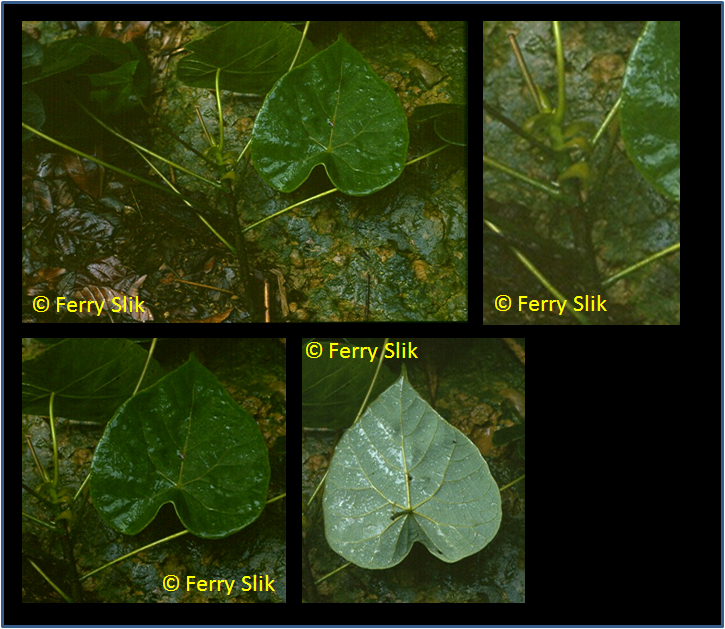Macaranga pachyphylla Müll.Arg., Prodr. 15(2): 999 (1866)
Name meaning 'thick leaves'.Synonyms
Macaranga brooksii Ridl.
Macaranga curtisii Hook.f.
Macaranga curtisii var. glabra Whitmore
Macaranga semiglobosa J.J.Sm.
Tanarius curtisii (Hook.f.) Kuntze
Diagnostics
Small trees up to ca. 13 m tall and 20 cm dbh, reproductive from 10 m tall and 12 cm dbh. Twigs
solid, glabrous, rarely glaucous. Stipules ovate to triangular, usually early-caducous, spreading,
not or (almost) completely surrounding the twigs, 7-17 mm long by 4-10 mm wide. Petioles glabrous,
up to ca. 15 cm long. Leaves alternate, peltate, ovate, 11-18 cm long by 6.5-10.5 cm wide,
length/width-ratio 1.29-1.88; secondary veins 4-11, ending in the margin or not (looping); leaf
base broadly rounded to cordate, peltate margin length 2-3.5 cm; leaf margin with or without glands;
leaf upper surface glabrous; leaf lower surface glabrous to hairy on veins, sometimes glaucous,
sparsely to numerously gland dotted. Staminate inflorescences branched; flowers clustered per
bracteole; bracteoles with entire margins. Pistillate inflorescences not branched; fruits ca. 8 mm
wide, completely gland covered.
Description
Small trees to 8(-13) m. Twigs slender, to 5 mm diam., terete, with conspicuous encircling stipule
scars, softly fawn tomentose to glabrous and glaucous. Stipules ovate, 12 by 10 mm, apex broadly
acute, dark brown, papery, glabrous to tomentose in centre, with sparse granular glands, erect
becoming recurved, subpersistent. Leaves: petioles 8-17 cm, slender, 2 mm diam., terete, weakly to
densely tomentose with at least a few spreading hairs; blades ovate, 9-18(-30) by 6-13(-25) cm,
coriaceous, base broadly rounded, 2-8 cm peltate, margin sometimes recurved with protruding
glandular teeth, apex acute to acuminate for 1 cm, drying chocolate brown, below with sparse
granular glands and velvety from spreading hairs on all main nerves, sometimes slightly glaucous,
5 main nerves at petiole insertion. Staminate inflorescences crowded, panicles dense, 9 by 3 cm,
becoming open, 19 by 7 cm, 3 axis orders, tawny tomentose to glabrous branches ascending to
spreading, to 7 cm long; peduncle 1-4 cm; main axis slender, 1.5-3 mm diam., terete or flattened,
coarsely ridged; lower branches often opposite, sometimes alternate, sometimes with a few axillary
branches; bracts variable, ovate, 3-10 by 1-5 mm, apex obtuse-acute or acuminate, dark brown,
papery, both sides slightly rusty pubescent to subglabrous, soon caducous; ultimate branches
slender, bearing crowded flower clusters; bracteoles variable, erect, overlapping, persistent,
ovate, strongly concave, 1-4 by 1-3 mm, usually with abrupt 1 mm caudate tip, margin entire, both
sides densely rusty furfuraceous. Staminate flowers 4-6, 0.5 mm diam.; pedicel 0.5 mm;, sepals
hairy; stamens 3-4, anthers 4-locular. Infructescences 4-10 cm spikes, with a few fruits towards
apex; axis terete or flattened, tomentose to glabrous. Fruits globose, often slightly depressed,
to 8 mm diam., black, leathery, shallowly grooved, closely granular glandular except grooves;
pedicel 10 mm, stout, tomentose; sepals large (1 mm), persistent, papery; stigmas small, 1 mm,
persistent, broad, apical. Seeds globose, striate, with sarcotesta. [from Flora Malesiana]
Ecology
In forest understoreys up to 1700 m altitude.
Distribution
Thailand, Peninsular Malaysia, Sumatra, Java and Borneo.
Local names
Borneo: Asang rabata, Sedaman kubal.
